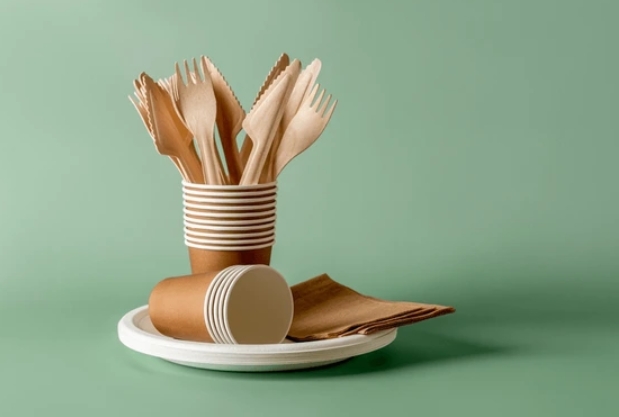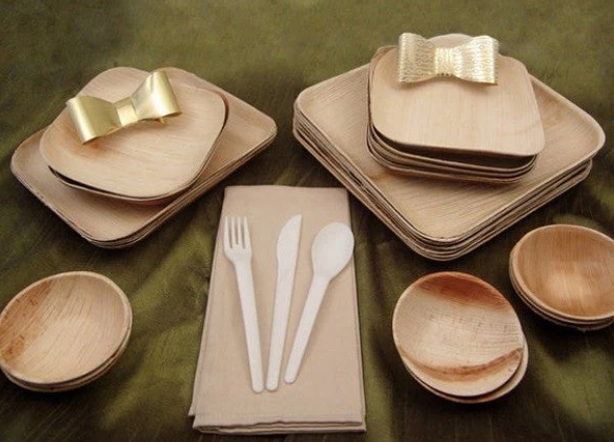
Content Menu
● Introduction to Disposable Tableware
>> Types of Disposable Tableware
● Manufacturing Process of Disposable Tableware
>> Paper Tableware Manufacturing
>> Sugarcane Bagasse Tableware Manufacturing
>> Cornstarch Tableware Manufacturing
● Benefits of Disposable Tableware for Parties
● Challenges in Disposable Tableware Manufacturing
● Recent Developments and Innovations
● Future Prospects
● Market Trends
● Consumer Awareness and Education
● Conclusion
● FAQs
>> 1. What materials are commonly used for disposable tableware?
>> 2. How are sugarcane bagasse plates manufactured?
>> 3. What are the benefits of using cornstarch plates?
>> 4. Why is disposable tableware essential for parties?
>> 5. What are the future developments in disposable tableware manufacturing?
● Citations:
Disposable tableware has become an essential component of modern parties and gatherings, offering convenience and reducing post-event cleanup efforts. The manufacturing process of disposable tableware involves various materials and techniques, depending on the type of product desired. This article will delve into the production methods of different types of disposable tableware, including paper, sugarcane bagasse, cornstarch, and biodegradable materials.

Introduction to Disposable Tableware
Disposable tableware is widely used in parties, events, and daily life due to its convenience and ease of disposal. It includes plates, cups, bowls, and cutlery made from materials like paper, sugarcane bagasse, cornstarch, and biodegradable plastics. These materials are chosen for their sustainability and ability to replace traditional plastic products.
Types of Disposable Tableware
1. Paper Plates and Cups: These are made from high-quality paper or recycled paper, often coated with wax or plastic to enhance water resistance. They are lightweight and eco-friendly, suitable for casual gatherings.
2. Sugarcane Bagasse Plates: Made from the fibrous residue of sugarcane after juice extraction, these plates are biodegradable and compostable. They offer excellent heat resistance and are ideal for serving hot foods.
3. Cornstarch Plates: These are produced from cornstarch, a renewable resource, and are biodegradable and compostable. They have good oil resistance and are suitable for both hot and cold foods.
4. Biodegradable Cutlery: Made from materials like cornstarch or sugarcane, this cutlery is designed to replace plastic utensils, offering an eco-friendly alternative.
Manufacturing Process of Disposable Tableware
Paper Tableware Manufacturing
The process of manufacturing paper plates and cups involves several steps:
1. Pulping and Mixing: Raw paper material is shredded and mixed with water to create a pulp. Chemical additives are added to enhance strength and water resistance.
2. Heating and Forming: The pulp is fed into a molding machine where it is shaped into plates or cups using heated molds.
3. Drying and Trimming: The formed products are dried to remove excess moisture and then trimmed to achieve uniform edges.
Sugarcane Bagasse Tableware Manufacturing
1. Collection of Bagasse: The fibrous residue from sugarcane juice extraction is collected.
2. Pulping: The bagasse is processed into a pulp using mechanical or chemical methods.
3. Molding: The pulp is molded into plate shapes under high temperature and pressure.
4. Drying and Sterilization: The molded plates are dried and sterilized to ensure hygiene and durability.
Cornstarch Tableware Manufacturing
1. Material Mixing: Cornstarch and other biodegradable materials are mixed in a specific ratio.
2. Compression Molding: The mixture is compression-molded into desired shapes using high pressure and temperature.
3. Finishing: The molded products are finished by removing dust and applying a sterilization process.
Benefits of Disposable Tableware for Parties
Disposable tableware offers several benefits for parties and gatherings:
- Convenience: Reduces cleanup efforts, allowing hosts to focus on enjoying the event.
- Sustainability: Many options are biodegradable and compostable, reducing environmental impact.
- Variety: Available in different materials and designs, suitable for various party themes.
Challenges in Disposable Tableware Manufacturing
Despite the advantages, there are challenges in the production and disposal of disposable tableware:
- Environmental Impact: While biodegradable, improper disposal can still harm the environment.
- Cost: Biodegradable materials can be more expensive than traditional plastics.
- Quality Variability: Consistency in quality can vary depending on the manufacturer.

Recent Developments and Innovations
The industry is witnessing significant innovations aimed at improving sustainability and efficiency:
- Advanced Biodegradable Materials: Research into new biodegradable materials that are more durable and cost-effective.
- Improved Recycling Processes: Efforts to enhance recycling technologies to handle biodegradable waste more efficiently.
- Sustainable Production Methods: Adoption of renewable energy sources and reduced water usage in manufacturing processes.
Future Prospects
As environmental awareness grows, the demand for sustainable disposable tableware is expected to increase. Manufacturers are focusing on developing more eco-friendly products and improving production processes to reduce waste and environmental impact.
Market Trends
The market for disposable tableware is expanding globally, driven by consumer preference for eco-friendly products. This trend is likely to continue as governments implement stricter regulations on plastic use and waste management.
Consumer Awareness and Education
Educating consumers about the benefits and proper disposal methods of biodegradable tableware is crucial. This awareness can help maximize the environmental benefits of these products and encourage further innovation in sustainable manufacturing.
Conclusion
Disposable tableware for parties is manufactured using a variety of eco-friendly materials and processes, offering convenience and sustainability. As environmental awareness grows, the demand for biodegradable tableware is expected to increase, driving innovation in this sector.

FAQs
1. What materials are commonly used for disposable tableware?
Disposable tableware is made from materials like paper, sugarcane bagasse, cornstarch, and biodegradable plastics. These materials are chosen for their sustainability and ability to replace traditional plastics.
2. How are sugarcane bagasse plates manufactured?
Sugarcane bagasse plates are made by processing bagasse into pulp, molding it into plate shapes under high temperature and pressure, and then drying and sterilizing the plates.
3. What are the benefits of using cornstarch plates?
Cornstarch plates are biodegradable, compostable, and have good oil resistance, making them suitable for serving both hot and cold foods.
4. Why is disposable tableware essential for parties?
Disposable tableware is essential for parties as it reduces cleanup efforts, offers convenience, and provides a sustainable alternative to traditional plastic products.
5. What are the future developments in disposable tableware manufacturing?
Future developments focus on improving biodegradability, enhancing recycling processes, and increasing the use of renewable resources to reduce environmental impact.
Citations:
[1] https://patents.google.com/patent/US20060154007A1/en
[2] https://www.mviecopack.com/news/are-disposable-plates-essential-for-parties/
[3] https://create.vista.com/photos/biodegradable-tableware/
[4] https://www.youtube.com/watch?v=UA7FypTFxRg
[5] https://www.sumkoka.com/bagasse-plate-guide.html
[6] https://universalimpresora.com/how-are-paper-plates-and-cups-manufactured/
[7] https://eventableware.com/a-complete-guide-disposable-plates/
[8] https://create.vista.com/photos/disposable-plates/
[9] https://www.youtube.com/watch?v=K3CnsUcb0Ew
[10] https://worldpapermill.com/disposable-tableware-manufacturing/
[11] https://patents.google.com/patent/CN1209484A/en
[12] https://www.youtube.com/watch?v=RpYF_DbewwM
[13] https://www.craftecopack.com/blog/from-raw-material-to-bagasse-plates-the-complete-manufacturing-process_b23
[14] https://theconiferous.com/blog/disposable-tableware/
[15] https://diyecobox.com/how-are-paper-plates-made-a-simple-guide/
[16] https://m.greenwoodcutlery.com/n1887827/Manufacturing-Process-of-Disposable-Wooden-Tableware.htm
[17] https://www.anchenggy.com/blog/must-have-disposable-partyware.html
[18] https://www.immould.com/cup-manufacturing/
[19] https://smartyhadaparty.com/blogs/home/the-best-way-you-can-party-with-disposable-plates
[20] https://worldpapermill.com/disposable-tableware-manufacturing/
[21] https://en.wikipedia.org/wiki/Disposable_tableware
[22] https://askpackagingltd.com/paper-plates-process/
[23] https://greentableware.hk/en-us/home/about
[24] https://www.youtube.com/watch?v=K3CnsUcb0Ew
[25] https://diyecobox.com/party-products-distributors-tableware-guide/
[26] https://www.kviconline.gov.in/pmegp/pmegpweb/docs/commonprojectprofile/DisposablePlatesDona.pdf
[27] https://pojstudio.com/blogs/inspiration/biodegradable-beautifully-designed-plates
[28] https://www.techno-preneur.net/technology/project-profiles/other/paper.html
[29] https://www.istockphoto.com/photos/disposable-plates
[30] https://www.shutterstock.com/search/disposable-plates
[31] https://www.saudifoodmanufacturing.com/exhibitor-videos/disposable-tableware-machinery
[32] https://www.shutterstock.com/search/paper-cup-manufacturing
[33] https://www.shutterstock.com/search/plastic-cup-production
[34] https://www.youtube.com/watch?v=RO5ljHX_uPc
[35] https://cuttheplastics.hk/images/download/Catering%20Sector.pdf
[36] https://www.pinterest.com/ideas/disposable-tableware/926363942160/
[37] https://www.youtube.com/watch?v=14wX5dW5cGk
[38] https://www.istockphoto.com/photos/disposable-tableware?page=2
[39] https://www.shutterstock.com/video/search/disposable-paper-plate

















